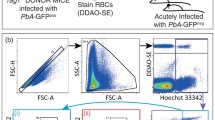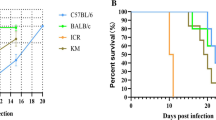Abstract
Immune-complex glomerular nephritis (ICGN) is known to develop during malarial infections, but little is known of its impact on renal function. A total of 24 male BALB/c mice were infected withPlasmodium berghei, and measurements of the glomerular filtration rate (GFR), parasitemia, and plasma solute concentrations were made on days 0, 7, 14, and 19 post-infection. Identical observations were made on 24 uninfected controls. The GFR declined progressively in infected mice from a mean of 201±2.1 (day 0) to 51±3 μl/min (day 19), whereas parasitemia rose to 47%±4.2% infected erythrocytes. In controls, the GFR remained unchanged, averaging 205±3.4 μl/min. Plasma osmolality rose in infected mice (326±1 vs 310±0.6 mosmol/kg in controls) as a result of increased chloride (123±0.7 vs 117±0.6 mEq/l) and urea (17.8±2.8 vs 9.3±0.7 mM/l levels). The data reveal a substantial deterioration of renal function during the course of a malarial infection that is short of outright renal failure.
Similar content being viewed by others
References
Aikawa M, Suzuki M, Gutierrez Y (1980) Pathology of malaria. In: Kreier JP (ed) Malaria, vol 2. Academic Press, New York, pp 47–102
Areekul S (1986s) Studies on the transcapillary escape rate of albumin and capillary permeability in rhesus monkeys infected withPlasmodium knowlesi. Ann Trop Med Parasitol 80:391–398
Areekul S (1986b)Plasmodium coatneyi: alterations of transcapillary escape rate and capillary permeability to fibrinogen in rhesus monkeys. Exp Parasitol 61:304–310
Baylis C, Blantz RC (1986) Glomerular hemodynamics. New Physiol Sci 1:86–89
Boonpucknavig S, Boonpucknavig V, Bhamarapravati N (1972) Immunopathological studies ofPlasmodium berghei-infected mice: immune complex nephritis. Arch Pathol 94:322–330
Boonpucknavig V, Boonpucknavig S, Bhamarapravati N (1973)Plasmodium berghei infection in mice. An ultrastructural study of immune complex nephritis. Am J Pathol 70:89–109
Brenner BM, Baylis C, Deen WM (1976) Transport of molecules across renal glomerular capillaries. Physiol Rev 56:502–534
Ehrich JHH, Voller A (1972) Studies on the kidneys of mice infected with rodent malaria: I. Deposition of gamma globulins in glomeruli in the early stages of the disease. Z Tropenmed Parasitol 23:147–152
Garnham PCC (1980) Malaria in its various vertebratehosts. In: Kreier JP (ed) Malaria, vol 1. Academic Press, New York, pp 95–144
George CRP, Partani A, Cameron JS (1976) Mouse malaria nephropathy. Am J Pathol 12:235–249
Haines H, McKenna TM (1988) Glomerular filtration rate in wild house mice,Mus musculus, acclimated to water scarcity. Comp Biochem Physiol, [A] 89:339–341
Hioki A, Ohtomo H (1989) Significance of blood urea nitrogen as an index of renal function in mice infected withPlasmodium berghei. Parasitol Res 76:127–130
Keeler R, Schnieden H, Gilles HM, Edington GM (1960) Kidney function in experimental malaria. Ann Trop Med Parasitol 54:267–271
Miller LH, Pavanand K, Buchanan RD, Desowitz RS, Athikulwongse E (1968)Plasmodium berghei: renal function and pathology in mice. Exp Parasitol 23:134–142
Poels LG, Niekerk CC van, Pennings L (1977)Plasmodium berghei: formation of secondary immune complexes in hyperimmune mice. Exp Parasitol 43:255–267
Sesta JJ, Rosen S, Sprinz H (1968) Malarial nephropathy in the golden hamster. Arch Pathol 85:663–668
Sitprija V, Vongsthongsri M, Poshyachinda V, Arthachinta S (1977) Renal failure in malaria: a pathophysiologic study. Nephron 18:277–287
Sokal RR, Rohlf EJ (1969) Biometry. Freeman & Co., San Francisco
Sullivan LP, Grantham JJ (1982) Physiology of the kidney, 2nd edn. Lea & Febiger, Philadelphia
Suzuki M (1974)Plusmodium berghei: experimental rodent model for malarial renal immunopathology. Exp Parasitol 35:187–195
Weise M, Ehrich JHH, Weise R (1972) Studies on the kidneys of mice infected with rodent malaria: II. Characterisation of urinary proteins by micro-disc-electrophoresis. Z Tropenmed Parasitol 23:399–405
Weise R, Konitz H, Weise M, Ehrich JHH (1973) Studies on the kidneys of mice infected with rodent malaria: III. Ultrastructure of the glomeruli at different stages of the disease. Z Tropenmed Parasitol 24:271–278
Yoeli M, Hargreaves BJ (1974) Brain capillary blockade produced by a virulent strain of rodent malaria. Science 184:512–513
Author information
Authors and Affiliations
Rights and permissions
About this article
Cite this article
Haines, H., Farmer, J.N. Glomerular filtration rate and plasma solutes in BALB/c mice infected withPlasmodium berghei . Parasitol Res 77, 411–414 (1991). https://doi.org/10.1007/BF00931636
Accepted:
Issue Date:
DOI: https://doi.org/10.1007/BF00931636




